 |
 |
 |
 |
 |
 |
 |
 |
 |
 |
 |
 |
 |
 |
 |
 |
 |
 |
 |
 |
 |
 |
 |
 |
|
|
|
|
|
|
|
|
|
|
|
|
|
|
|
|
|
|
|
|
|
|
|
|
|
|
 |
|
|
|
|
|

|
|
|
|
|
|
|
|
|
|
1. Which Zambian player qualified for the 2005 FIDE World Cup tournament?
|
|
|
|
|
|
|
|
|
|
|
|
|
|
Stanley Chumfwa had a strong showing in the 2005 African Individual Championships, thus becoming the second Zambian to qualify for the World Chess Championships. Amon Simutowe had qualified in three previous FIDE tournaments, but had a sub-standard tournament and did not qualify.
Chumfwa is one of the brightest talents in Zambia which also has a sizable contingent of younger players looking to make an impact. Chumfwa was paired with French Grandmaster Etienne Bacrot and despite a valiant fight, lost the match 2-0.
These trips by Chumfwa (and before him Simutowe) certainly provide inspiration to the rest of the Zambian chess community to seek the highest of heights.
|
|
|
|
|
|
|
|
|
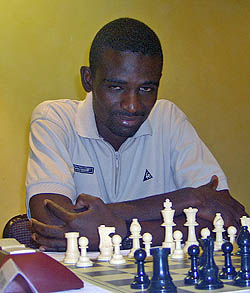
|
|
|
|
|
|
|
|
|
|
|
|
|
|
|
|
|
|
|
|
|
2. Who was the first player to earn the FM title representing Jamaica?
There have been many Jamaican players who have shown the potential to become international stars, the first to earn the island's first FM title was Grantel Gibbs. Since subregional zonals award titles based on a single performance, Gibbs earned his FM stripes by scoring 5/9 in the 1999 subzonal in Venezuela. Warren Elliott would achieve the same 5/9 result in the 2001 subzonal tournament held also in Venezuela.
|
|
|
|
|
|
|
|
|
|
|
|
|
|
3. Which player is known for the following opening against the Alekhine Defense… 1.e4 Nf6 2.e5 Nd5 3.c4 Nb6 4.a4 a5 5.Ra3!? (diagram below)
|
|
|
|
|
|
|
|
|
|
|
|
|
|
Interesting question. The first player of record employing this opening is none other than FM Emory Tate! While Tate is known for his attacking prowess, what is often overlooked is his innovative opening ideas. (Note: See Tate's g5!? idea in Sveshnikov!)
In this line dubbed the "Tate variation," white activates his rook with 5.Ra1-a3!? The rook is developed 5-10 moves earlier than normal and is shifted over to the kingside (to g3) or the center of the board for brutal attacks. Other strong players have played it, but it remains a Tate novelty. Following are a couple of games of note (See Ra3!? games)
|
|
|
|
|
|
|
|
|
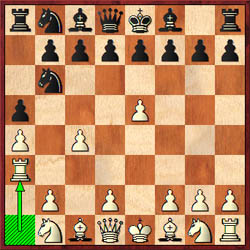
|
|
|
|
|
|
|
|
|
|
|
|
|
|
|
|
|
|
|
5. The Wilbert Paige Memorial Tournament was held in what historic place?
|
|
|
|
|
|
|
|
|
|
|
|
|
|
This tournament will go down as one of the most important in Black history. This tournament was special for a numbers of reasons, but most notably, it included ten of the strongest players of African descent in the world.
The Wilbert Paige Memorial was held in Harlem, New York in the Hotel Theresa, the place where Fidel Castro sought refuge after being denied accommodation during a UN meeting in 1960. Malcolm X also held meetings here for his OAAU organization.
The hotel is perched off of 125th street which is the home of the famous Apollo Theatre and the birthplace of the "Harlem Renaissance" of the 1920s. (See some beautiful pictures here).
|
|
|
|
|
|
|
|
|

|
|
|
|
|
|
|
|
|
|
|
|
Hotel Theresa
adjacent to Harlem's 125th street
|
|
|
|
|
|
|
|
|
|
|
|
|
|
|
|
|
6. Which player was the first Black woman in Africa to earn the Woman's Grandmaster (WGM) title?
|
|
|
|
|
|
|
|
|
|
|
|
|
|
This is a relatively recent occurrence so most will know that the answer is the reigning African Women's champion, Tuduetso Sabure of Botswana. Sabure is probably not as widely known as her compatriot Boikhutso Mudongo, who won a bronze medal in the 2002 Olympiad tournament in Bled, Slovenia.
Sabure won the title by virtue of her sparkling result at the African Individual Championships held in Lusaka, Zambia. She was later granted the Women's Grandmaster title becoming the first women in sub-Saharan African to accomplish that feat.
Sabure has a promising younger sister named Ontiretse and will serve as a viable role model for all of the African Diaspora when she competes in the FIDE World Cup next month.
|
|
|
|
|
|
|
|
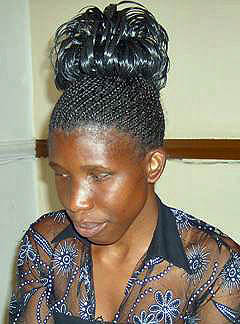
|
|
|
|
|
|
|
|
|
|
|
|
|
|
|
|
|
|
|
7. This player from Latin America earned a GM norm in the 2004 Olympiad Chess team tournament.
Miguel Mosquera is perhaps not well-known, but by all accounts is a promising player by virtue of his result at the 2004 Olympiad. Mosquera has represented his country in three consecutive Olympiad tournaments (2000, 2002, 2004). His best score came at the 2004 Olympiad where he scored 7˝-4˝ (2539 TPR) on board 1 for a GM norm. Jorge Renteriá is also a top Afro-Columbian player. Pontus Carlsson was also born in Columbia, but raised in Sweden. He is well-known to The Chess Drum audience.
With a 2394 rating and no title at the time, he beat GMs Pablo Ricardi (Argentina), Eduardas Rozentalis (Lithuiania), Dashzaveg Sharavdorj (Mongolia) and held Evgeny Agrest (Sweden) equal. Mosquera's games show a lot of energy and determination. Here is a taste of his attacking style as he dispatches of IM Manuel Mateus of Angola. (See game)
8. He is the only Black player to qualify for the U.S. Championship three consecutive times. Name him.
Stephen Muhammad would be the answer here. Muhammad's solid style lends itself well to consistent results against top-level players. For the past three qualifying rounds, he has come up big in tournaments and is the only Black player to qualify multiple times. This is crucial in motivating others in the African Disapora to compete at the highest levels.
Muhammad's first qualification came just after GM Maurice Ashley became the first Black to qualify. In 2002, Muhammad qualified at the Chicago Open; in 2004, Muhammad qualified at the World Open; in 2005 Muhammad got the bid at the 2005 North American Open completing his "threepeat" qualification. Emory Tate also qualified for the 2005 U.S. Championship.
|
|
|
|
|
|
|
|
|
|
|
|
|
|
9. What date 'The Chess Drum' launched?
|
|
|
|
|
|
|
|
|
|
|
|
|
|
The Chess Drum was launched 12th of February, 2001 at 12:00am. The website sprouted from an idea conceived by Daaim Shabazz for a communicative vehicle to inform the chess world about the activities pertaining to players of African descent around the world.
Originally planned as a quarterly international magazine, the idea took hold during the "dotcom" era of e-Business. The site has grown from its original issue of 10 pages to more than 4600 pages and has been visited in over 180 countries and territories.
What has distinguished The Chess Drum from other major sites the covering of chess news in countries that would not normally see the light of day. The site provides Black players a platform from which to display their unique contributions to the sport of chess.
|
|
|
|
|
|
|
|
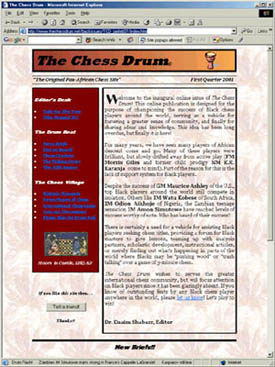
|
|
|
|
|
|
|
|
|
|
|
10. Which person played the followed moves as white?
1. e4 e5 2. Nf3 Nc6 3. d4 exd4 4. Nxd4 Qh4 5. Nb5 Qxe4+ 6. Be2 Kd8 7. O-O a6 8. N1c3 Qe8 9. Nxc7 Kxc7 10. Nd5+ Kd8 11. Bf4 d6 12. Nb6 Ra7 13. Bxd6 Bxd6 14. Qxd6+ Bd7 15. Bg4 Nf6 16. Bxd7 Qe7 17. Qd3 Ne5 18. Qd4 Nexd7 19. Nxd7 Qxd7 20. Qxa7 Qc8 21. Qd4+ Qd7 22. Rad1 Qxd4 23. Rxd4+ Kc8 24. Re1 1-0
All of the players listed in the choices are capable of playing such a game, but the featured game was played in 1874 by Theophilus Thompson. While FM Ronald Simpson plays swashbuckling chess and moves his queen freely throughout the board, he usually plays 1.c4 and 1.Nf3. Chuck Green is a Master who doesn't play much these days, but his gambit style of play is very unique and makes an impression on those who have witnessed his play. Of course, FM Emory Tate is known for his inventive attacking style. He is one the preeminent tacticians in the world. Another person who could have made the list was FM Dr. Philip Corbin of Barbados, known as the "Caribbean Tal." (See Thompson's game against C.H. Blood)
|
|
|
|
|
|
|
|
|
|
|
|
|
|
11. Howard Daniels is on record as the young Black master in American history to earn the Master's title at the age of 15 years and 4 months. Who was the next youngest Black player to earn the title?
This player of note has been mentioned many times on The Chess Drum and was known as a prodigy of his time. KK Karanja took the U.S. chess scene by storm in the 1980s when he began showing promise in scholastic tournaments in the New York area.
Born of Kenyan parents, the young boy was placed in gifted programs and by age 10, he had eclipsed the 2100-rating mark. As a result, he won the Apis prize for top scholastic player under age 13. Karanja would only see a 100-point rating improvement in the next five years, but earned the National Master title by 15 years and 7 months. After mediocre results and some disenchantment, he quickly disappeared from the scene.
|
|
|
|
|
|
|
|
|
|
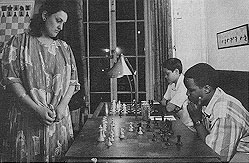
|
|
|
|
|
|
|
|
|
|
KK Karanja playing the Alehkine's Defense against Georgia's GM Maia Chiburdanidze in an 1987 simul at the Marshall CC. Chirburdanidze was the Women's World Champion at the time.
|
|
|
|
|
|
|
|
|
|
|
|
|
|
|
|
|
|
|
|
12. Choose the Black player who accompanied Bobby Fischer to Iceland during his Championship match with Boris Spassky.
|
|
|
|
|
|
|
|
|
|
|
|
|
|
This is a piece of rare history. One could easily pick any one of the answers because of were figures during the Fischer era. However, Archie Waters was one to accompany Fischer to Iceland for his championship against Boris Spassky. Both Frank Street and Walter Harris were on the scene and knew Fischer. In an interview, Harris recounted how people had Fischer's personality all wrong.
The William Scott story was also interesting. A story (as told by Michael Bacon of Atlanta) had Scott going down to San Antonio in 1972 to see the famous Church's Fried Chicken tournament. Fischer didn't play, but made an appearance. Scott met him, requested an autograph and stated how he once placed ahead of Fischer in the 1956 U.S. Open. World Champion Fischer curtly stated, "Oh yeah. Well what's your rating now?" Scott was taken aback and meekly mumbled something about being only an "Expert." Fischer stated, "um huh" and walked away.
Read story on Scott.
On the other hand, Waters was said to have accompanied Fischer as a table tennis partner, but was also an accomplished draughts player and co-authored a book on "pool checkers" with Clyde Black. He too had an encounter with a World Champion, but this was with draughts legend Timothy Sijbrands. Here is one account from Tim Krabbé:
"Word was that Fischer was interested in draughts, and there was a little black guy from New York in his entourage, Archie Waters, who was said to be his ping pong partner, and a very strong draughts player. I could see myself and Archie Waters, envoys paving the way for a historic meeting. But when Sijbrands and Waters got together, it turned out Waters had never heard of him and also, he thought he was the World Champion--in another variant of the game. It was a moving sight to see my World Champion and this other world champion explaining their rules to each other."
Read story on Waters.
|
|
|
|
|
|
|
|
|
|
|
|
|
|
Compiled by: Dr. Daaim Shabazz (17 February 2006)
Black History Chess Quizzes
2004 (#1, #2) 2005 (#1, #2) 2006 (#1)
|
|
|
|
|
|
|
|
|
|
|
|
|
|
|
 |
|
 |
|
|
|
|
|
|
|
|
|
|
|
|
|
|
|
|
 |
|